Displaying items by tag: education
Bridgestone Prize camp 2015
Winners from this years’ art competition entitled ‘Predators of the Cape’ were all treated to an environmental camp in the Cederberg in November. This time of the year is when temperatures are meant to be hot…
We had 19 participants consisting of talented young artists and their friends. A few young artists from Die Coetzee Ateljee in Piketberg had already been on a prize camp with us earlier this year but this did not stop them from being excited for yet another camp! That is what the Cederberg does to people, it has the ‘I will come back factor’ because there is just so much to do and see in the Cederberg.
As soon as we were in the mountains and on the gravel roads, I switched off the music in the bus and created space for the serene beauty to take over the entertainment. I could instantly feel the excitement from the group and I wondered if they knew that what lay ahead of them would be two days of pure enjoyment and endless exploring.
After camp orientation and setting up our tents we took a drive to Stadsaal where we had a look at the famous San rock art, the group learned about the history of the area whilst taking in the magnificent views. I like prompting the groups to think about what it would have been like living back then, as a nomad living off the land. The children absolutely loved exploring and climbing the rocks and venturing into some of the dark sandstone caves. It was difficult to drag these children away from the rocks because they loved it so much. The next day had its own big adventure, we climbed the Wolfberg cracks and we went the adventurous way – through the thin crack! The children performed better than the adults in the one tricky part in the crack but everyone eventually made it through. It was very cold up at the top and we could still see a snow dusting on Sneeuberg peak from the snowfall the night before. Even with the extreme conditions and challenges that this hike brought, there were no complaints or disgruntled participants, everyone did very well that day. Riëtte, our intern had been hoping she would get to climb Wolfberg during her time in Cederberg and finally she did.
We visited Truitjieskraal in the afternoon for some more exploration and rock art. I got the young artists to draw their own rock paintings, this was a very cool exercise to do and a brilliant way to connect with nature and the area.
We found one scorpion that night on our night walk, this one was hiding under a rock but we could see its luminous pincers poking out. Seeing scorpions under the UV light is always a hit with the groups and it is a sight none of them will forget anytime soon. On our last day we went to check the camera trap up the river but unfortunately we did not get any pictures this time, we were hoping for that leopard that has been regularly visiting the river just up from the campsite. We did see many tracks of various other animals including Genet. Speaking of Genets, we have a resident Genet that visits the camp-site at night and leaves tiny paw-prints all around the kitchen and near the bins, obviously hoping to find abandoned morsels of food.
It was sad to leave the Cederberg but I have no doubt that this camp prompted some new drawing ideas, new memories, new passions and new friends! I would like to thank the volunteers who helped with supervision and the very important task of cooking – Thank you Pierre and Bianca Jordaan, Saneeya Adams and Caroline Gill for your support and help with this camp, thank you to the participants for entering our art competition and for helping to spread the word about leopards and other animals. A big thank you to Bridgestone who sponsored not just all the costs for this camp but for everything from the framing of the artworks to the calendars that will be coming out in January next year. Without the sponsorship from Bridgestone, the art competition and the Prize camp not have been possible this year!
Eight Thousand Port Jackson Seedlings!
by Catherine Philips
Last Saturday the Huis Andrew Murray children joined together with Thrive Hout Bay in combating the spread of Aliens.
Thrive Hout Bay is an NGO that works closely with the locals of Hout Bay with the aim to make Hout Bay a better place. They focus on encouraging an eco-friendly approach and promote this at schools and to the public.
Thrive had invited its partners and friends to a day of 'uprooting Port Jackson' up on the slopes behind Hout Bay, along the Baviaanskloof river. These slopes have been affected in various ways by the fire that happened earlier this year and most notably is the proliferation of the Port Jackson. The spread of these seedlings is extensive and this poses a major problem for the natural vegetation and the eco-system. Port Jackson is adapted to fire and when the fire happened earlier this year, the seeds spread like 'wildfire'. These little aliens are all coming up and it is best to take them out now before they get too big.
The HAM children were very effective in pulling up the plants and each group got a marked out block where they had to work. We were given tools and a scorecard and were asked to take out as many seedlings as possible and record our number. Penny Brown from the Mountain Club of South Africa gave a talk on the best techniques to pulling them out i.e. you have to get it at the root otherwise it will coppice and just grow again!
The children had a great time getting their hands dirty in the sand and in total, together with local helpers, the group pulled out about 8000 Port Jackson seedlings that day!
This is a great achievement and will help that little bit more in keeping the mountain slopes free of aliens. Well done to all the children, they had lots of fun and worked hard at the same time. They were rewarded with a visit to Hout Bay beach where they all cooled off in the water. A big thank you must be given to Springbok Atlas who sponsored the transport for this outing and made this day possible, to Richard, our driver who was superb and patient with us. Thank you to Bronwen Lankers-Byrne from Thrive who organised the event, to Penny Brown for her help and knowledge sharing, Mike from Thrive for your support and also to Geduld from HAM who helped me with managing all the children.
Hoofweg Primary hike Lion’s Head, Experience from a Volunteer
This past Thursday, I was fortunate enough to be invited to tag along on The Cape Leopard Trust’s hike to Lion’s Head with the Hoofweg Primary School, one of the eco-schools from Wesbank. As a Communications intern, I was thrilled to be able to take part in conservation efforts that extend beyond the office. Hadley Lyners, Environmental Educator for the CLT and leader of the hike, expressed to me that the majority of these students have to deal with daily issues of poverty, environmental degradation, gangsterism and drugs. They rarely get the opportunity to explore a place as beautiful as Table Mountain National Park.
I was also accompanied by Nicole le Roux, who provides support for the education team and was also on her first hike with the group. The excitement on the students’ faces when we met them at the trailhead was unforgettable. We started off with some brief introductions and had each student tell us something that they love; responses ranged from playing sports to speaking Afrikaans. Then we set off on a light stroll up the mountain where Hadley frequently paused to teach the kids about plants, geology, and wildlife, and to let them get a good look at their surroundings with a pair of binoculars.
As we continued to ascend the mountain, the trail gradually became more difficult and, as the students ran by me leaping over rocks and flowers without hesitation, I quickly discovered that I am terribly out of shape! I was also reminded of a quote from Disney’s Alice in Wonderland, “Curiosity often leads to trouble.” Let’s just say some of the kids were a little too curious and excited, running ahead to see what else there was to explore. As heartwarming as it was to see their enthusiasm for being out in nature, we had to remind them that safety comes first when you are on a mountain.
The scenery throughout our hike was unmatched by anything I have experienced so far in this beautiful country. Daisies and all different coloured flowers dotted the grasses along the trail, drawing your eye to the silhouettes of the far off mountain ranges and the vast ocean behind them. Students discovered some cool rock caves to explore and even managed to catch a black girdled lizard. Hadley held the critter out for everyone to see and explained a little bit about it and why we should let animals roam around freely, when suddenly the lizard hurled itself right at me! I’m not sure whether it was the kids’ screams or the lizard flying towards my face that frightened me more. Either way it was quite the moment to remember.
The last leg of the hike proved to be a very steep climb, but with Hadley’s help, the students navigated it with ease. Some of the boys even had to help me! But the view from the top of Lion’s Head proved to be worth every minute of it. It was there that our group took a long rest on the rocks, sharing snacks, taking pictures, and checking off all the plant and animal life we saw on the fact sheet Hadley provided us with. Hadley made me try some biltong for the first time as well while we waited to regroup. I’m not one for beef jerky, but this was surprisingly tasty!
Just before we began our descent, one of the boys pointed out a bird soaring by in the distance that he had seen earlier. It turned out this was the last black eagle left on Table Mountain. Moments like this are what solidify my belief that we should be educating kids about the importance of the environment and wildlife so that they grow up with an appreciation and adoration for our earth’s most precious and quickly vanishing wonders. Hopefully, by allowing these students to experience nature with us, they too will want to save it. Now if I could get paid to go on a hike like this one every day, I might have to change career paths! Until next time...
Stay happy and wild,
Jeanie
On Vacation with Nature - The Cape Leopard Trust 2014 Holiday Programme
Every year during the mid-year school vacation members of the public have the opportunity to send their children on an adventure with us. This year our theme was ecosystems and looking at fynbos-forest-, dune and wetland ecosystems in particular. Within 2 hours of advertising, India Baird, from NGO Rock Girl booked up all the seats available for 14 young girls aged 11-15 years old, 4 boys from the Jag Runners club and their 2 supervisors from Mannenberg. The area around Mannenberg is plagued by gang violence in the on-going turf wars. Rock Girl started their involvement with Red River Primary 4 years ago. When they were asked, the children commented that they wanted a safe space. It was at this school where the first Rock Girl bench was built. The attractive benches symbolise real safe spaces in some of the most dangerous, challenged communities in Cape Town. By day 2 I had to drive past a murder scene en route to pick up the participants. Every morning I would hear about senseless shootings and people who died the day before. Besides this tragedy, the suburb has litter strewn everywhere. Here is an account of their journey with us.
Day 1 - Zandvlei Wetlands
Participants were shown how litter impacts the estuary and the surrounding neighbourhoods and the effects of littering on the environment in general were explored. Birds were observed at a distance and one sea gull was even seen trying to eat plastic, a common problem these days. We worked out that if 20 of us each picked up 20 papers per day it would amount to 400 papers per day. If we did this over 4 weeks 11 200 papers would be picked up. Taking advantage of the great weather the youngsters were given an opportunity to canoe on the vlei, and for all of them this was a first.The chance to see and touch a snake was met with awe, and they even got to see the endangered Western Leopard Toad and a terrapin. Great fun was had and the experience set the tone for what was to follow over the next few days.
Day 2 - Kirstenbosch Gardens
The largest of our 9 national botanical gardens did not disappoint and with so much on offer we crammed in as much as we could. Participants were shown the Garden of Extinction, felt and smelt fragrant plants, followed the braille trail, explored Afro-montane forests and learned about the various storeys in a forest and discovered the 4 main groups of fynbos plants. The group trekked up Skeleton Gorge to see the Skeleton Waterfall before meandering back through the garden towards its newest attraction, the Boomslang Walkway, where they could imagine being a bird high up in the trees. They learned some important history about the garden and its cycads before moving on towards the Conservatory.
Day 3 - Silvermine Loop Hike
We had hiked up to the lookout point over Hout Bay through misty conditions. Upon arrival the skies cleared enough for us to absorb breath-taking views of arguably the best scenery Cape Town has to offer. After a bite to eat we moved on towards the Fire Hut and Elephant Eye Cave on the opposite side of the mountain. Along the way we encountered the King Protea and other interesting plants and frogs in the streams that we crossed.
Day 4 - Biodiversity Park and Sea Point Promenade
With the weather turning out to be quite cold and rainy, our plans to climb Lion’s Head were cut short. It was time for a back-up plan and we initially headed off to the old harbour wall in the Waterfront before deciding to head towards the Green point Biodiversity Park. After exploring the park and learning about recycling, indigenous culture and useful plants, rain stopped play and shelter was sought. When the rain finally eased the kids enjoyed playing on the impressive park facilities, and to end the day we could not resist some exercise on the Sea Point Promenade with a round of putt-putt for good measure.
Day 5 - Lion’s Head, Signal Hill and the Iziko Museum & Planetarium.
With the forecast of rain for the day the plan was to visit the Iziko Museum. Since we were close by, we first stopped at the start of the Lion’s Head trail to see the Rock Girl bench. In total there are 32 benches around the city which represent peace and winning back our communities through bravery and positivity. A second bench on Signal Hill was a good enough reason to stay up there a little longer before heading off to the museum.
Day 6 - Tygerberg Hill Nature Reserve
This reserve covers 309ha and boasts over 560 plant species, 23 of which are on the red data list. 8 are endemic to Cape Town and 3 to the reserve itself. The diversity of species found is vast with 24 different mammals, 137 bird species, 22 reptile and 7 frog species as well as numerous butterflies. The Eastern slope of the hill is being restored while the Western slope is close to a stretch of pristine Swartland Shale Renosterveld. From the top one could see how fragmented natural areas are amidst the urban sprawl. We found tracks of Bontebok, evidence of an aardvark that had opened up a termite mound, as well as a jackal buzzard and lots of interesting plants.
Day 7 - Soetwater Environmental Education Centre (Kommetjie) overnight stay
With mountain and sea in close proximity the Slangkop Mountain and beach below provides a home for thousands of birds and other mammal species. Plant diversity ranges from strandveld to mountain fynbos. Before setting off on a walk, participants were given a presentation of leopards and other mammals found on images taken by our camera traps. Indigenous fish traps tell a story of how modern man utilised nature for survival and a lens into a huge shell midden provided interesting insights into a bygone era. Participants explored a little, practised doing a bird count, and explored their own creativity by building sand creatures. There was ample time to swim for a bit and the group even managed a night hike up to the top of a huge dune.
Day 8 - Soetwater Environmental Education Centre (Kommetjie) overnight stay
After breakfast and batteries recharged our participants headed off along the beach towards South Africa’s tallest lighthouse. Exploring the rocky shore, they observed creatures found amongst the rocks and learned that our country boasts 62 different species of limpet, with the USA in second place with 2 species of limpet. We found tracks of an Aardvark, and a klipspringer midden was a surprise discovery. Klipspringer is being reintroduced into the Table Mountain National Park after being exterminated through hunting in earlier years. Back at base camp, it was time to play and the learners got stuck into some outdoor activities: soccer, volley ball, basketball and even playing with puppets and musical instruments.
Day 9 - The Masque Theatre and Rocky shore ecology study along the St James walkway
For many of the participants it was the first time they had visited a theatre. The youngsters enjoyed the story of ‘Hoerikwagga’ (Table Mountain) through the eyes of 2 mischievous baboons characters called Smiley and Knuckles. The two take you on a journey of discovery about places and animals found on the mountain. The actors morphed seamlessly into various creatures providing insights into the natural world in a funny and entertaining way. Having visited many of the places mentioned in the performance it served as a great way for the youngsters to consolidate what they have seen and learned. Later strolling along the St James walkway there were birds to see and they children had a closer look at life between the tides by using a quadrant study along a line sect. Various species were identified and the youngsters learned how to differentiate which occurred within the spray-, high tide-, middle tide- and low tide zones. Afterwards the participants were asked to do a charcoal drawing of what they saw the most in their quadrant surveys or otherwise any favourite creature or sea plant observed.
Day 10 - Leopard’s Gorge Hike and a research exercise using a camera trap
It was by no accident that the Harold Porter national botanical garden was chosen as the final destination. With all four ecosystems represented here, participants could observe and further consolidate their knowledge about the fynbos-, forest-, wetland- and dune ecosystems. After a brief stop at the Wolfgat Nature Reserve and a scenic drive along Clarence Drive, the indigenous garden at Harold Porter in Betty’s Bay was explored. The youngsters gathered and shared information from the story boards. We then trekked up the gorge to the top to see the beautiful waterfalls. Crossing the flowing streams provided a good challenge, with me being one of the casualties of having wet shoes and socks. It was met with fun and laughter. We set up a camera trap and participants pretended they were leopards, klipspringer, rabbits and other mammals of the forest. It was a wonderful experience for them to see how our researchers manage to get images of animals in their natural surroundings. Settling down to a picnic afterwards we held a quiz, complete with a prize for the one who answered the most questions correctly. It was heart-warming to hear how the yougsters had retained information and that they could provide good answers.
Our closing circle revisited our journey together, unpacking what we had learned and how we can strive to make a difference for the environment and its people. As the trip came to an end everyone reflected on the new friendships that had been made during an amazing adventure.
A big thank you to everyone involved for making this adventure possible, especially the acting deputy of Red River Primary, Mr Sydney Hendricks and his devoted wife and teacher, Cheryl. During a time when most teachers are resting during their holidays, the two of them showed up every day to lend support and love to the participants. Not only did Sydney and Cheryl provide meals for the youngsters, they even took them running over the weekend, clearly demonstrating their dedication and commitment. A special thankyou too for my colleague, Jaclyn Stephenson, for her invaluable support throughout.
Hadley-John Lyners: CLT Environmental Educator
Reflecting on my ongoing journey with The Cape Leopard Trust
After 300 days of working with The Cape Leopard Trust (CLT) as environmental educator, I feel the need to reflect on what can only be described as an incredible journey. Infected by the enthusiasm of the dedicated CLT colleagues and equally great participants of the education programme I find myself more enthusiastic than ever about what can still be achieved by the educational programme in the Cederberg and in the areas around Cape Town.
I have already learned so much about nature, places and most importantly the people taking part. One of my favourite quotes by Nelson Mandela is that “education is the most powerful weapon which you can use to change the world” and so I try to do just that. Our organisation’s focus is to use research as a tool for conservation, to find solutions to human-wildlife conflict and to inspire interest in the environment through an interactive and dynamic environmental education programme.
The support given to the education project by our CEO, Dr Quinton Martins, is exemplary and other research scientists can learn from him in this regard. For example, he has repeatedly been involved in showing participants old leopard traps, talking about leopards and conservation and even showing participants how to use GPS’s to mark klipspringer middens for research. His passion for the conservation of the Cape mountain leopard is remarkable and this is reflected in the great support by our wonderful donors and sponsors.
His equally dedicated partner, Elizabeth, who heads our education team, too leads by example and is constantly pushing the boundaries in terms of what the education programme can achieve through the activities presented to participants, as well as networking with like-minded groups to achieve a better world for people and the environment. Without discounting the value of educational activities, her foremost objective is to stimulate an appreciation for nature among participants by exposing them to the beauty and fascination nature has to offer.
I have had the pleasure of working with two excellent interns, Sune Rossouw and Nadine Sydow. Both of them were dedicated, enthusiastic, fit and hard-working, knowledgeable, love food and (most importantly) great fun. I have created a place in my heart for them as friends forever. Recently Jaclyn Stephenson joined our team as the CLT Cape Town-based environmental educator and I am so happy to be working with her. She has helped me to discover even more places and more importantly allowed me to see a different way of delivering environmental education. Her enthusiasm and drive is a real asset to the CLT.
I could go on and on about the rest of my colleagues, but I think you get the idea that everyone working for this organization is really great and I feel privileged to be able to work with such a dedicated and supportive team.
From the word go I got to learn so much about the different animals, birds, reptiles, plants, geology of the Cederberg, rock paintings, the heritage of the people there, astronomy, animal tracking, survival, navigation, fossils, photography, hiking experiences and the logistics around leading walks to name but a few. Participants have had a chance to explore their own limitations and I have seen folk grow in terms of their life experiences and their own life skills in a short space of time. What also fascinates me is to see the dedication of teachers, group coordinators and volunteers in terms of providing the back-up support on camps and outings, not just the meals, but most importantly real caring about participants’ well-being. I have lost count of the emotional lumps in my throat I get when I see and experience what can be described as real mentoring, friendship and love.
One of our key approaches is not be prescriptive about what participants have to do for the environment. The last thing we want to do is to indoctrinate participants and to create an army of people who might in future do things which might prove to be wrong because of our personal beliefs about solutions for the environment and its people. All we can do is expose people to the issues that are prevalent, state the facts and allow them to make up their own minds about what is right and wrong. For example, a 2013 study by the University of Colorado shows that an estimated 600 000 bats were killed by wind turbines in 2012. Wind turbines are seen as a potential solution to the United States’ need for foreign oil. Bats save farmers in the United States billions of dollars every year by eating insects that could destroy crops. The bats collide with the wind turbines’ blades yes, but strangely most deaths occur by a disease called White Noise Syndrome. The blades cause a subtle drop in atmospheric pressure, which in turn cause internal hemorrhaging in bats called barotrauma, when thin sacs surrounded by capillaries in their lungs over-expand and burst. (http://abcnews.go.com/Technology/wind-turbines-kill-thousands-bats-day/story?id=20997657 ) So in effect wind turbines as a potential solution to an energy crisis also have a downside. What we could see as a solution can also be a problem.
What we offer with the CLT education programme is a chance to discover and learn in a way that is fun. At best we can only try to educate by equipping participants with knowledge, the necessary skills to be reflexive in thought, address attitudes and values. We encourage participants to take part in discussions so that they may be able to monitor and evaluate a situation for themselves in order to make sense of the world around them.
Please forgive us though if we talk a lot about the leopards. They are simply the coolest cats!
Enjoy the photographs of some of our experiences!
By Hadley-John Lyners, CLT environmental educator
Insight from an Intern - A Camp to Remember
Residents from the Camphill Village, West Coast arrived in the Cederberg on the 7th of March 2013. I honestly did not know what to expect. For those who don’t know, Camphill Village is home to a group of special needs adults with a variety of challenges. It is a place of inspiration, offering a farm style village environment where the residents participate in making the various dynamics of the village work. From baking bread and growing vegetables, to running the dairy, the residents contribute towards creating a sustainable living from the resources available, and it has proved so successful that the fresh produce not only provides for the residents, but also creates an income and is sold on to many happy customers. What I saw left me in awe. These were the friendliest, most honest and openhearted people I had ever met.
During the customary leopard presentation, they did not hold back, enthusiastically asking questions and exceptionally interactive, offering personal observations and insights.
Next we took them to a place most later reflected was the highlight of the weekend, the Stadsaal rock art and rock formations. They people were awestruck at the concept of rock art staying on the rocks for so many years, and the knowledge of Dassiepis being a proven medicinal substance was met with mirth. The rock formations were what everyone enjoyed most. One of the ladies, Sally, likened one of the rocks to the Titanic. This is when I first noticed Sally’s difficulty walking, which is due to the fact that she is very short sighted, and how one of the gentlemen, Gerard, always held her hand to help when scrambling up and down the rocks.
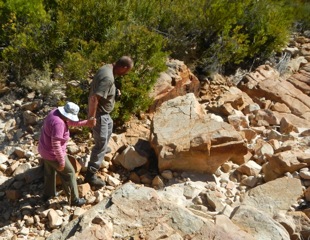
Some of the ladies who had gone to Stadsaal previously shared their insight and knowledge of the names that were written on the rocks, happy to tell their fellow participants about it. All this while ardent nature enthusiast, Gregory, was looking for signs of any animals making imitation baboon sounds in an attempt to spook the Villagers. Everyone would break into hysterical laughter.
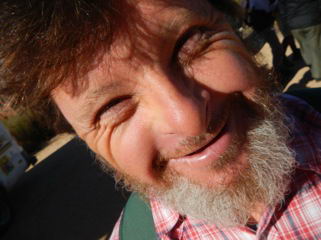
The next morning Callum and I were greeted with stories of the baboons in the night and how Gregory made quite a show imitating them.
The weather was quite chilly, so armed with raincoats and binoculars; we took a drive to place with true Fynbos (which comprises of Ericas, Proteas and Restios). As I led the hike I frequently asked if the rain was too heavy and whether we should go back. The answer was always no. So up and up we went, enjoying the sounds of birds and always hopeful of the sight of a leopard just around the corner. As we walked we saw two beautiful Verreaux’s eagles and stopped for a moment to watch them.
Finding fossils in the Karoo was enjoyed by all, firstly because we saw some magnificent Sutherlandia’s and because of the beautiful and plentiful fossils. We saw examples of the red and yellow ochre the San would have used to make paint for rock art.
The parents of one of the volunteers, Mama and Papa, enjoyed Truitjieskraal the most. They inquired about everything, from how the rocks were formed, to the fires and how they affect the plants. This would have been fine if they were asking the questions in English, but they spoke German and had to use hand and facial gestures to overcome the language barrier.
What I enjoyed most was the night walk and astronomy. The German volunteers told us about their stars and Matthew told of ours. A leopard enthusiast, Justin, braved the dark and walked ahead of the group to find a leopard. He swore that he heard one just a few metres away from him, but for safety reasons he says he decided not pursue it.
I will hold the friendship I made with Camphill Village with me forever, and one day I may even volunteer there myself. The sense of community and togetherness was tangible amongst the group and inspiring for me. I can honestly say that for me this was the best camp I have experienced with the CLT thus far.
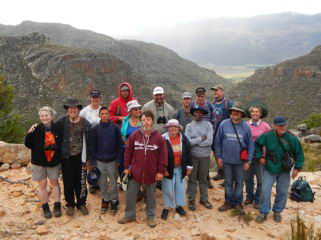
Wonga Nongqotho
CLT education project intern
What's new in the Education Project?
The dawning of a new year brings with it a new camp season in the Cederberg, along with the some fresh new equipment, people and ideas.
We are very grateful for our new 7ft trailer (‘Ayla the Traila’), generously sponsored by a fairy godmother who wishes to remain anonymous. Thanks also to Venter for providing us with a substantial discount that made it all possible.
The CLT Education Project has two new interns who will be working with us for the first camp season. Callum Clark brings with him a passion for nature, a guide’s qualification and a particular interest in birds. Wonga Nongqotho has a special love for the Cederberg, a thorough knowledge of plants and their uses, combined with an infectious enthusiasm. We are very happy to have them as part of the team and hope that they will gain valuable experience from this internship.

CLT interns, Wonga and Callum
It was a great pleasure to welcome the Botha’s Halte group to our campsite last weekend. The children won a competition run by the ‘Greenfingers Project’ last year, in which they had to create a calendar with leopard drawings. The prize was a CLT camp sponsored through the Witzenberg Municipality by the Essen municipality in Belgium. For most of these farm children it was their first time away from home!
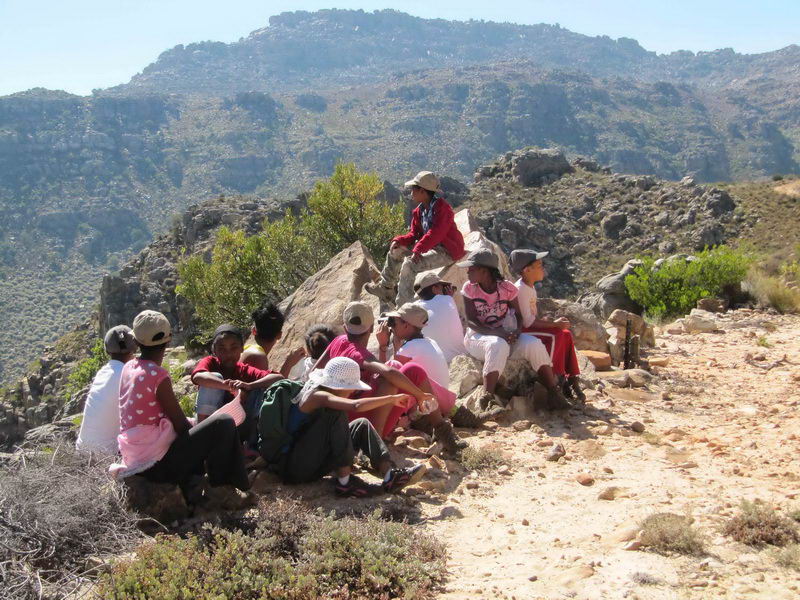
Children from Botha’s Halte resting on their walk to check a camera trap up in the mountains
One of the highlights for the children was looking through our new binoculars sponsored by the Deutsche Bank Africa Foundation.

What do you see? Black Eagles maybe…
The Cape Leopard Calendar Competition, sponsored by BridgestoneSA,is now underway and is open to school and club groups in the Western Cape. Entries from two age categories, grade 5 – 7 and high school, are eligible to win a CLT camp for 21 people, as well as 50 of the winning calendars professionally printed. The response from teachers across the region so far has been fantastic and we can’t wait to see what the children produce. We will endeavor to keep you updated. If you would like competition information please email [email protected].

Adventures with CLT, An Intern’s Perspective
I came to Cape Leopard Trust to complete a 3-month internship as part of my continued South African Game Ranger career enhancement. My goals were two-fold, to become involved in the on-going research and to assist with the eco-school camps. I quickly learned how to set up and breakdown the campsite for school groups. Trying to teach kids how to put up tents can be challenging.
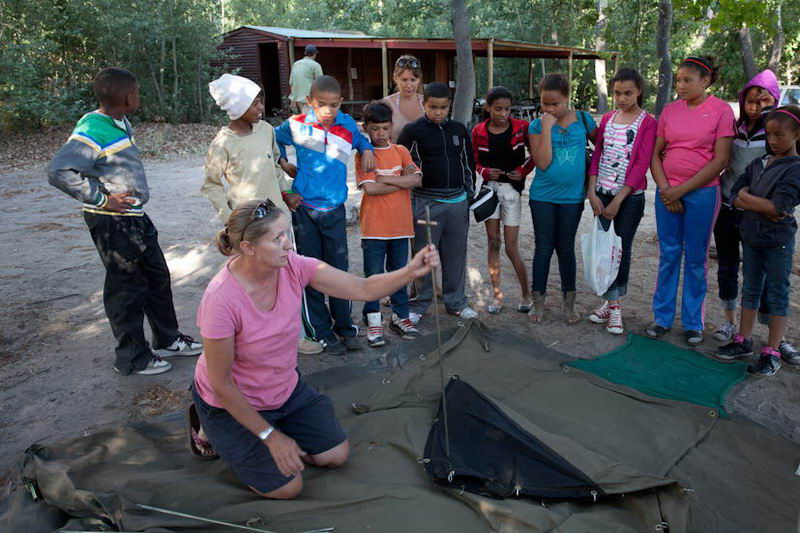
Demonstrating how to put up a tent
Learning about the various animals of the Cederberg was enjoyable as it allowed me to provide presentations and answer questions from students about animal behavior and habits.
Taking the school groups on educational outings tested my own level of fitness. In time I became a better rock climber. The job requires lots of endurance for the long hikes with students. My favorite activity became teaching the students about tracking skills and then taking them on expeditions around the campsite and river areas looking for tracks. Prior to coming to CLT I had never used a GPS. I learned how to program coordinates from collared leopards and caracal data into a GPS and lead students to kill sites to collect scientific data.
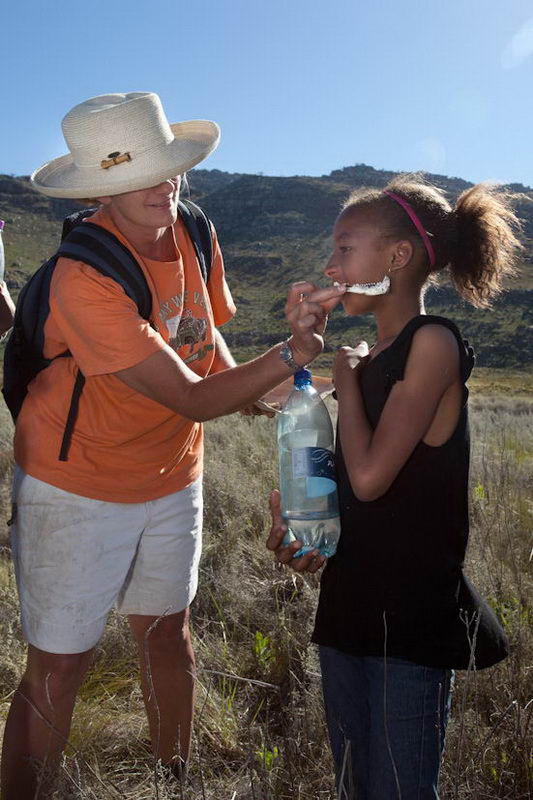
Having fun showing a student which bone we had found at a caracal kill site
The students as well as I liked checking the camera trap photos to see what species of animals visit the area. I even learned the fundamentals that go into setting up a camera trap. Lastly, I was able to improve my 4x4 driving skills through the search for Titus, the leopard, by checking the caller signal on a his trap utilizing VHF telemetry to monitor for trigger status. I loved the quiet morning drives into the karoo. I know some of the time that Titus must have been watching and gave me at least a paw wave.
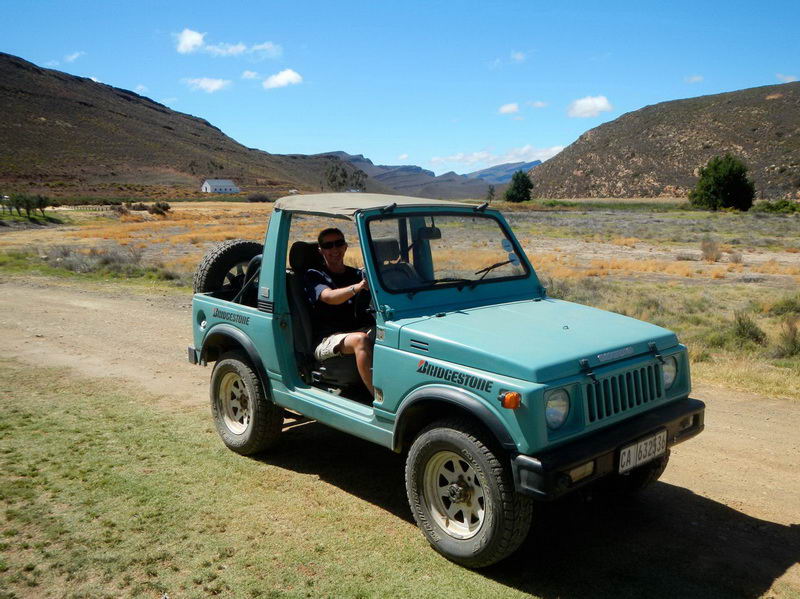
Off to check the trap in Frikkadel, the CLT Suzuki
The most fascinating work to me involved assisting Quinton with the setting of a variety of leopard traps: single closed-end cage traps, walk-through double door cage traps, and foot hold traps (some baited). Leopard research is essential to continue to learn more about these valuable apex predators.
I would like to thank the Martins’ for providing me with the opportunity!
Sheryl Key-Moore
The CLT Education Project is looking for an intern to help with camps during both camp seasons in 2013. Please email [email protected] for more details.
Children Help with Predator Research
I hear the Land Cruiser engine outside. It’s Quinton, back from his flight. Was he successful, I wonder? He comes in beaming, “I got them all! And you won’t believe where Patch is…” Quinton rushes over to the computer to download the GPS data to take a look at where the young male leopard, M17 “Patch”, has been moving for the past four months. He also downloads the data that he got for F5 “Lizzie” the female leopard, and the male caracal, MC3 “Klonkies”. “Oh my word, come check this out! Look where Klonkies has been cruising!”
The two most exciting parts of getting the data from the GPS collars is seeing where these cats have been moving and then looking for clusters of points which indicate kill sites. If a cluster shows that the leopard or caracal was in one place for over 24 hours we have found that it means it was feeding on a kill and that its prey was fairly large – dassie or larger. The fun part comes in when we actually go out there and investigate these points, looking for any signs of the remains of the kill.

Satellite map showing caracal GPS points with a cluster highlighted
Leopards eat almost everything. It is common to find their scats near a kill with a hoof inside it, or quills, in the case of when porcupine are eaten. The clues are not always obvious. We look for hair, because the leopards lick and pluck the hair off their prey before they feed; rumen, the vegetarian stomach contents that the leopard finds distasteful; bits of bone, most often the skull, sometimes a piece of leg bone; and scats, from which we can identify the animal that was eaten. Caracals have a different eating style, preferring the meat and leaving most of the skeleton.
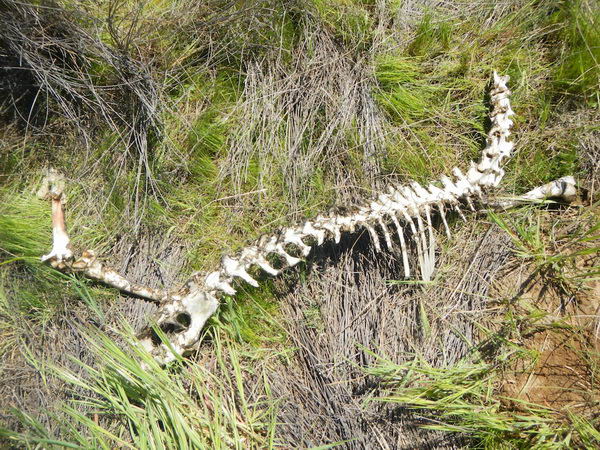
Remains of a caracal kill
The information gleaned when kill sites are investigated produces an unbelievably accurate study on the predator’s diet. Quinton used this method in his PhD and a scientific paper in the Journal of Zoology has since been published.
However, leopards and caracal don’t necessarily have their restaurants close to the roads. In fact leopards seem to choose their locations carefully – a spot with shelter and a view to die for (excuse the pun)! This is where the groups participating in the environmental camps come in. Groups are given a kill site’s GPS point, and head off into the veld on this novel kind of treasure hunt, active members in the research process.
During the last three camps, ten kill sites were investigated, and nine of them successful. So what did we find? The young leopard had eaten grey rhebuck, common duiker and even a baboon – unusual for the Cederberg. The caracal on the other hand had eaten grysbok and klipspringer.

Pointing to the remains of a klipspringer – a pile of hair and bones
During their school holidays, the Buys family volunteered their time to help the CLT with some of the more remote kill sites. Here is their story:
During the last weekend of the holidays, Quinton had given us 13 cluster sites to survey in the Cederberg. The cluster data ranged in age from less than a month to several years old, grouped within a 60 square kilometer area near the Matjiesrivier Nature Reserve. Returning to a base camp on a nearby farm each night, we spent 4 days hiking and managed to get to 10 clusters.
The going was tough in this stony region - leopards don’t stick to footpaths and vehicle trails!
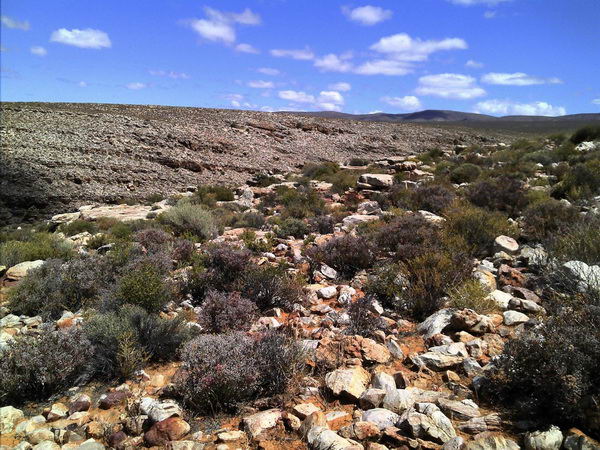
Rough hiking in the Cederberg Karoo
Most clusters were typical: overhangs, caves and near water; except one that was on the apex of a mountain. Some clusters remain a mystery – generating no prey or scat evidence. We could only speculate why the leopard paused here – perhaps a date, but more likely crows and jackal picked the spot clean.
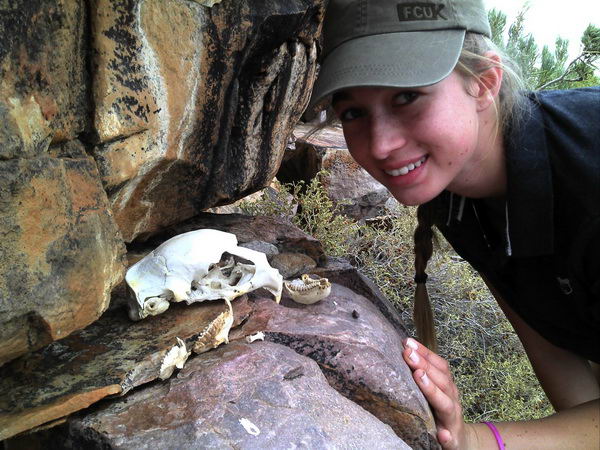
Prey samples and scat were collected and returned to CLT for further analysis, but obvious remains included dassie, porcupine, what might be large bird, some small antelope (and also some livestock). We’re especially looking forward to hearing about the identity of “our” mystery skull.
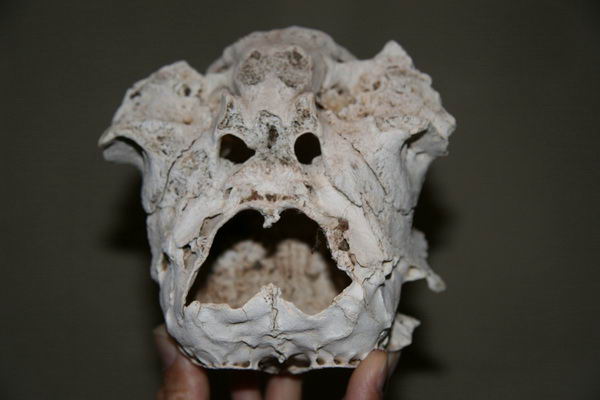
We can certainly recommend cluster hunting as a great volunteer activity that also made much of what we’d read about the leopard so much more real.
Thank you to all these groups who put such enthusiastic effort into helping the CLT gather data for this revealing research.
By Elizabeth Martins, Education and Outreach Coordinator
Adventures in the Cederberg
The Grade 7 class from the ZenzeleniWaldorfSchool in Khayelitsha have returned home after a four-day camp in the Cederberg sponsored by the National Lottery Distribution Trust Fund. It was not the first camp for their teacher, Tinashe, who brought his Grade 7s to us for a camp in 2009, the first year the CLT’s education project started even before we had our own campsite set up. Tinashe is so taken with the environmental camps that he is planning to set up a similar programme when he returns to Zimbabwe, “It was such a good challenge for them, getting to the top of the mountain. Most of the children were born in Cape Town and have never been out of it before so this was a totally new experience for them. They may not realise the value now but it will stay with them forever.”
As we got out of the bus for the big hike up Welbedacht kloof, the children noticed an unpleasant smell in the air. We all scattered out to find the source of the smell until we came upon Quinton’s baited leopard trap. We explained how the traps worked and why it was important to catch and collar the leopards. Matthew then introduced the group to the fynbos, Ceder trees and hiking obstacles – in this case, rivers and rain! We hiked up to a large old Ceder tree beneath which we had our lunch. Then began the race to the top! Having risen to the challenge and reached the top, it started to pour with rain and everyone was soaked by the time we reached the bus again.
The following morning the group went to Stadsaal where they learned about the historical significance of the area, how it was used by the San bushmen and later as a stronghold and meeting place by the Boers in the Anglo-Boer war. The children then enjoyed exploring the beautifully sculpted rocks on their own.
Later in the day the focus turned to animals, as the children were split into groups, some learned animal tracking and others examined and drew a variety of animal skulls. During the tracking sessions, the groups each chose an animal track and made a plaster cast of it. When the first group was out tracking, they came across a large puff adder sunning himself on the edge of the road. While keeping a safe distance the children engaged in a lesson about these snakes. The children weren’t scared, but rather very curious. They learned from their own observation that the snake had recently had a meal – there was a sizeable bulge in its middle. Seeing the puff adder definitely reinforced what had been said about how they need to keep their eyes open when walking in the veld.
The highlight of the whole trip for many of the children was the walk they did upstream that afternoon to a beautiful pool where they could swim. The children played in the water till they exhausted themselves and came out shivering but happy.
That night Matthew introduced them to star-gazing, where they learned to identify some of the main constellations, like Scorpio, and learned to find their direction using the Southern Cross. The Milky Way was a bright band across the sky.
This was a great adventure for these children, outside of city life, a chance to breathe fresh air, drink clean mountain water, experience silence, run and play and just be themselves and feel calmness. One girl said, “If only I could stay for two more weeks!” When asked what she would do she said, “Climb every mountain.”






















